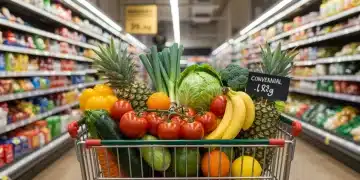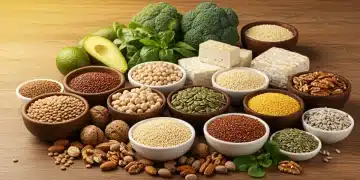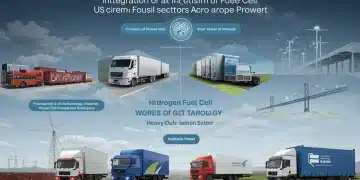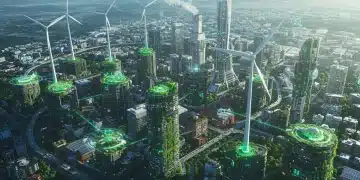Urban Farming Tech: Boosting Food Security with 2025 Vertical Garden Systems
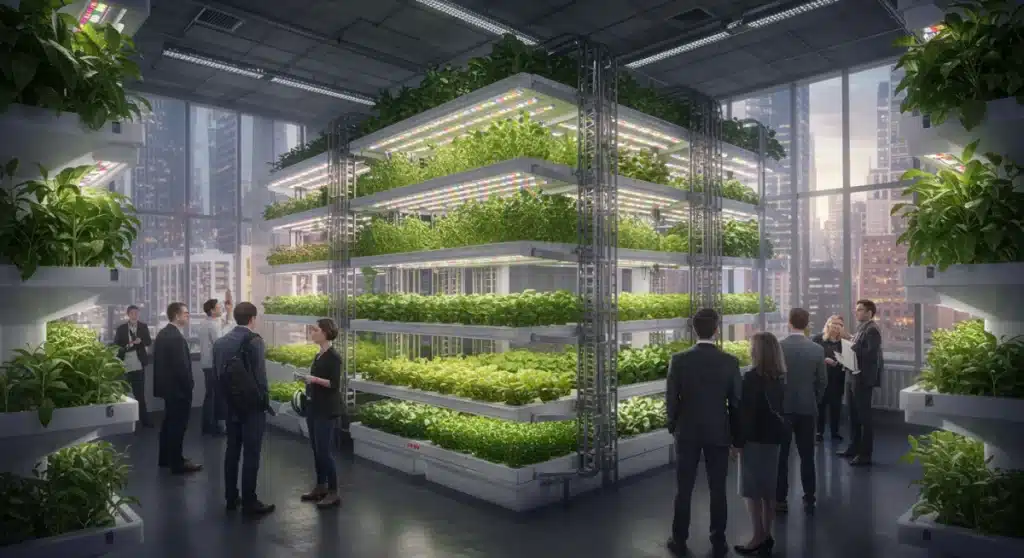
Urban farming tech, particularly 2025 vertical garden systems, is rapidly advancing, offering practical solutions to boost food security and sustainability in urban environments globally.
Recent developments in urban farming tech are poised to revolutionize how cities grow food, with 2025 vertical garden systems leading the charge. These innovative approaches are not just theoretical; they are providing practical solutions to enhance food security and sustainability across urban landscapes worldwide.
The Rise of Vertical Gardens in Urban Settings
Vertical gardening, a core component of modern urban farming tech, is experiencing an unprecedented surge in adoption. This method involves growing crops in vertically stacked layers, often indoors, allowing for significant food production in minimal space. Cities globally are now actively integrating these systems to address pressing environmental and logistical challenges.
The concept of vertical farming has evolved dramatically, moving from experimental setups to commercially viable operations. This shift is driven by advancements in hydroponics, aeroponics, and aquaponics, which enable year-round cultivation regardless of external climate conditions. The promise of fresh, locally grown produce is reshaping urban food supply chains.
Technological Innovations Driving Growth
Several key technologies are propelling the expansion of vertical gardens. These innovations make the systems more efficient, productive, and accessible to a wider range of urban environments. From advanced lighting to sophisticated climate control, every element plays a crucial role.
- LED Lighting Systems: Energy-efficient LEDs provide optimal light spectrums for plant growth, mimicking natural sunlight and accelerating crop cycles.
- Automated Environmental Controls: Sensors and AI manage temperature, humidity, CO2 levels, and nutrient delivery, ensuring ideal growing conditions.
- Hydroponic and Aeroponic Systems: These soilless methods conserve water by recirculating nutrient solutions, drastically reducing water usage compared to traditional farming.
- Data Analytics and AI: Machine learning algorithms optimize planting schedules, predict yields, and detect potential issues, enhancing overall efficiency.
Addressing Food Security Challenges with 2025 Systems
Food security remains a critical global issue, and urban farming tech offers a potent solution, particularly with the advancements expected by 2025. Vertical garden systems can significantly reduce reliance on long-distance transportation of food, making fresh produce more accessible to urban populations and mitigating supply chain disruptions.
The ability to grow food directly within or very near consumption centers means fresher produce with higher nutritional value. This proximity also lowers carbon emissions associated with transportation, contributing to more sustainable food systems. The focus is on creating resilient food sources that can withstand external shocks, from climate change to economic instability.
Impact on Local Communities
The implementation of these advanced systems has a profound impact at the local level. They provide opportunities for community engagement, education, and job creation, strengthening local economies and fostering a sense of self-sufficiency. Many urban farms are designed to serve local food banks and schools.
- Community Engagement: Local residents can participate in farming activities, fostering a connection to their food sources.
- Educational Opportunities: Vertical farms serve as living laboratories for students and the public to learn about sustainable agriculture.
- Job Creation: The operation and maintenance of these high-tech farms create new employment opportunities in green industries.
- Increased Access to Fresh Produce: Inner-city areas, often food deserts, gain consistent access to healthy, affordable food.
Practical Solutions for Sustainable Urban Living
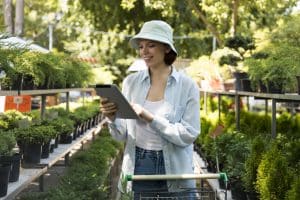
The practical solutions offered by urban farming tech extend beyond just food production. These systems are integral to creating more sustainable, livable cities. By integrating vertical gardens into urban planning, cities can optimize land use, manage waste, and improve air quality.
Vertical farms often repurpose abandoned buildings or underutilized spaces, transforming them into productive assets. This smart land use is crucial in densely populated urban areas where horizontal space is scarce. Furthermore, the closed-loop nature of many vertical farming systems minimizes environmental impact.
Resource Efficiency and Environmental Benefits
One of the most compelling aspects of vertical gardens is their remarkable resource efficiency. They use significantly less water and land compared to traditional agriculture, and their controlled environments reduce the need for pesticides and herbicides.
- Water Conservation: Hydroponic and aeroponic systems use up to 95% less water than field farming due to recirculation.
- Reduced Land Use: Vertical stacking allows for maximum yield per square foot, freeing up valuable urban land.
- Minimized Chemical Use: Controlled indoor environments drastically cut down on pest and disease issues, reducing reliance on harmful chemicals.
- Lower Carbon Footprint: Reduced transportation distances and efficient energy use contribute to lower greenhouse gas emissions.
Recent Updates and Global Adoption Trends
The landscape of urban farming tech is continuously evolving, with new updates emerging regularly. Recent reports indicate a rapid increase in the number of vertical farms worldwide, driven by both private investment and government initiatives. Major cities are now actively competing to become leaders in sustainable urban agriculture.
For instance, Singapore, a nation with limited arable land, has made significant strides in vertical farming, aiming to produce 30% of its nutritional needs locally by 2030. Similarly, cities in Europe and North America are seeing substantial investments in large-scale indoor farms, often integrated into industrial parks or mixed-use developments.
Key Players and Innovations
Several companies are at the forefront of this revolution, developing cutting-edge systems and expanding their operations. These innovators are pushing the boundaries of what’s possible in controlled environment agriculture, bringing advanced solutions to market.
- Crop Varieties: Beyond leafy greens, advancements allow for the vertical cultivation of berries, herbs, and even some root vegetables.
- Modular Systems: Companies are developing modular, scalable vertical farms that can be easily deployed and expanded in various urban settings.
- AI-Driven Crop Management: Sophisticated AI platforms are now fine-tuning environmental parameters for specific crop varieties, maximizing yield and quality.
- Integration with Renewable Energy: Many new vertical farms are designed to run on renewable energy sources, further enhancing their sustainability credentials.
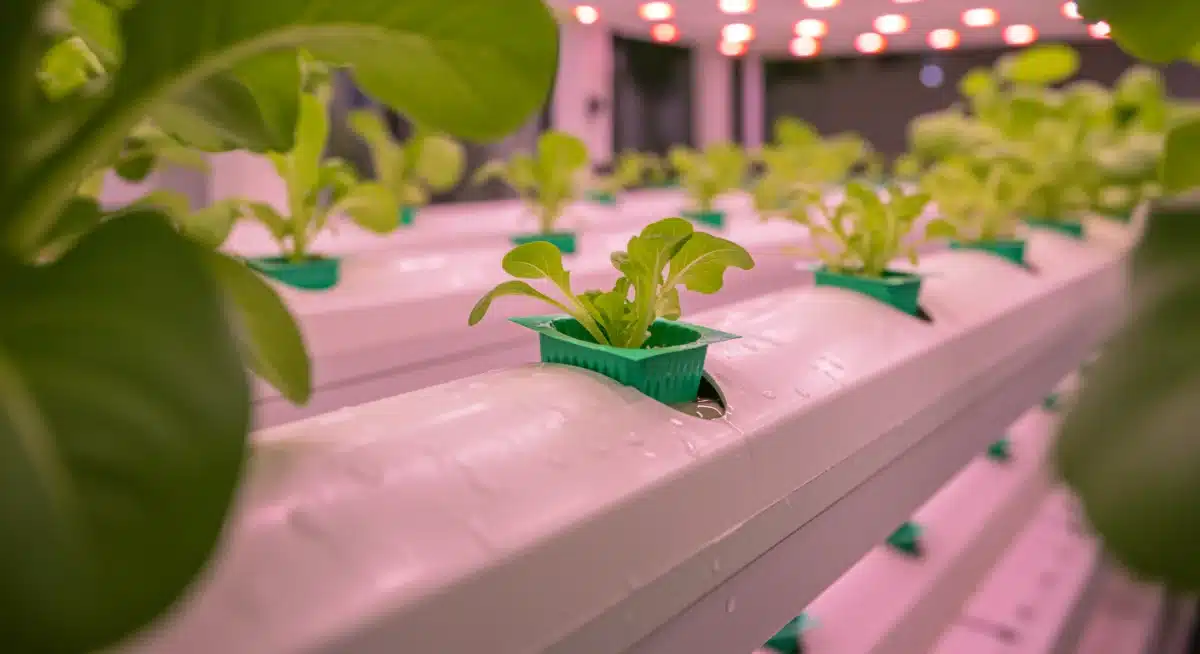
Challenges and Future Outlook for 2025 Vertical Garden Systems
While the promise of urban farming tech is immense, there are still challenges to overcome. High initial setup costs, energy consumption, and the need for specialized technical expertise are significant hurdles. However, ongoing research and development are consistently addressing these issues, making vertical farming more viable.
By 2025, many of these challenges are expected to be significantly mitigated. Economies of scale, coupled with technological refinements, are projected to drive down costs. Furthermore, educational programs are being developed to train a new generation of urban farmers and agri-tech specialists.
Overcoming Obstacles
Innovators are actively working on solutions to make vertical farming more accessible and cost-effective. This includes developing more affordable modular systems and integrating energy-efficient technologies.
- Cost Reduction: Mass production of components and improved system designs are lowering initial investment costs.
- Energy Efficiency: Advances in LED technology and HVAC systems are reducing energy consumption, often complemented by renewable energy integration.
- Skill Development: Vocational training and academic programs are preparing a skilled workforce for the growing vertical farming industry.
- Policy Support: Governments are increasingly offering incentives and grants to support the establishment of urban farms.
The Role of Data and AI in Next-Gen Urban Farming
The future of urban farming tech, especially the 2025 vertical garden systems, is intrinsically linked to data science and artificial intelligence. These advanced tools are no longer just supplementary; they are becoming fundamental to optimizing every aspect of plant growth and farm operations. Real-time data collection and analysis enable unprecedented levels of control and efficiency.
AI algorithms can process vast amounts of environmental data, from nutrient levels to light intensity, making precise adjustments that maximize yield and minimize waste. This intelligent automation reduces human error and allows for continuous improvement in growing protocols. The integration of IoT devices ensures a constant flow of information, creating truly smart farms.
Smart Farming for Optimal Yields
The application of AI in vertical farms allows for predictive analytics, anticipating plant needs before issues arise. This proactive approach ensures healthier crops and more consistent production, which is crucial for meeting urban food demands.
- Predictive Growth Models: AI analyzes historical data and real-time conditions to forecast crop growth and harvest times with high accuracy.
- Automated Nutrient Delivery: Sensors monitor nutrient uptake, and AI systems precisely adjust the composition and timing of nutrient solutions.
- Pest and Disease Detection: Image recognition AI can identify early signs of pests or diseases, allowing for immediate, targeted interventions without widespread chemical use.
- Resource Optimization: AI fine-tunes energy, water, and labor usage, leading to significant operational cost savings and environmental benefits.
| Key Point | Brief Description |
|---|---|
| Vertical Garden Adoption | Rapid increase in urban areas globally due to technological advancements and sustainability goals. |
| Food Security Boost | Reduces reliance on external food sources, ensuring fresh, local produce access for urban populations. |
| Resource Efficiency | Significantly lower water and land use, minimal chemical dependency compared to traditional farming. |
| AI and Automation | Integral for optimizing growth, predicting yields, and managing resources in 2025 systems. |
Frequently Asked Questions About Urban Farming Tech
Urban farming tech refers to the application of advanced technologies like vertical gardens, hydroponics, and AI to grow food efficiently within city environments. Its goal is to maximize yield in limited spaces while minimizing environmental impact and enhancing local food security.
By 2025, vertical garden systems are expected to significantly boost food security by enabling year-round, local food production, reducing reliance on lengthy supply chains, and providing fresh, nutritious produce directly to urban populations, especially in food-scarce areas.
Practical benefits include drastic reductions in water and land usage, elimination of pesticides, lower transportation costs and emissions, and creation of local jobs. These systems also repurpose urban spaces and foster community engagement around sustainable food practices.
Crucial technologies include energy-efficient LED lighting, automated environmental controls, soilless growing methods like hydroponics and aeroponics, and advanced data analytics with AI. These elements work synergistically to optimize plant growth and resource management.
Current challenges involve high initial setup costs, significant energy consumption, and the need for specialized technical expertise. However, ongoing innovations, economies of scale, and renewable energy integration are steadily addressing these obstacles, improving viability.
Looking Ahead
The evolution of farm monitoring technologies is ushering in a new era for agricultural efficiency, enabling real-time data insights, predictive maintenance, and improved yield management. As climate variability and resource constraints intensify, farms that adopt intelligent monitoring stand to gain in both sustainability and profitability. In the months ahead, we expect further refinements in sensor capabilities, connectivity solutions, and data integration frameworks.
Future breakthroughs will likely come from tighter integration between hardware, analytics, and AI-driven decision support systems. For practitioners seeking to transform their operations, leveraging resources such as livestock monitoring platforms like https://www.monnit.com/applications/agriculture-livestock-monitoring/?gad_source=1&gad_campaignid=65854069&gbraid=0AAAAADxKTwPf0CXQ95690cH98tPDq3Iny&gclid=CjwKCAjwxrLHBhA2EiwAu9EdM5OY6pOaisKruJHb5LMAd-ySW1sDn-BuXI3YfcGY7zixoBbQyHZU4hoClaoQAvD_BwE can offer practical insight into how sensors and monitoring systems are already being deployed in actual farming settings. Those who begin today — deploying sensors, streamlining data pipelines, and embedding monitoring into daily routines — will set the benchmark for future-proof agriculture, achieving both resilience and competitiveness.


